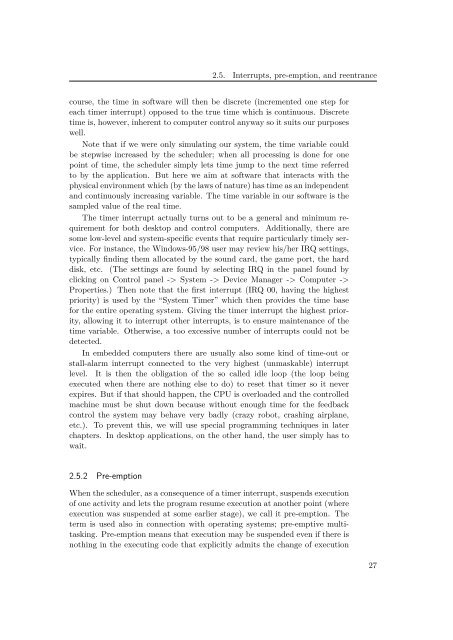JAVA-BASED REAL-TIME PROGRAMMING
JAVA-BASED REAL-TIME PROGRAMMING
JAVA-BASED REAL-TIME PROGRAMMING
Create successful ePaper yourself
Turn your PDF publications into a flip-book with our unique Google optimized e-Paper software.
2.5. Interrupts, pre-emption, and reentrance<br />
course, the time in software will then be discrete (incremented one step for<br />
each timer interrupt) opposed to the true time which is continuous. Discrete<br />
time is, however, inherent to computer control anyway so it suits our purposes<br />
well.<br />
Note that if we were only simulating our system, the time variable could<br />
be stepwise increased by the scheduler; when all processing is done for one<br />
point of time, the scheduler simply lets time jump to the next time referred<br />
to by the application. But here we aim at software that interacts with the<br />
physical environment which (by the laws of nature) has time as an independent<br />
and continuously increasing variable. The time variable in our software is the<br />
sampled value of the real time.<br />
The timer interrupt actually turns out to be a general and minimum requirement<br />
for both desktop and control computers. Additionally, there are<br />
some low-level and system-specific events that require particularly timely service.<br />
For instance, the Windows-95/98 user may review his/her IRQ settings,<br />
typically finding them allocated by the sound card, the game port, the hard<br />
disk, etc. (The settings are found by selecting IRQ in the panel found by<br />
clicking on Control panel -> System -> Device Manager -> Computer -><br />
Properties.) Then note that the first interrupt (IRQ 00, having the highest<br />
priority) is used by the “System Timer” which then provides the time base<br />
for the entire operating system. Giving the timer interrupt the highest priority,<br />
allowing it to interrupt other interrupts, is to ensure maintenance of the<br />
time variable. Otherwise, a too excessive number of interrupts could not be<br />
detected.<br />
In embedded computers there are usually also some kind of time-out or<br />
stall-alarm interrupt connected to the very highest (unmaskable) interrupt<br />
level. It is then the obligation of the so called idle loop (the loop being<br />
executed when there are nothing else to do) to reset that timer so it never<br />
expires. But if that should happen, the CPU is overloaded and the controlled<br />
machine must be shut down because without enough time for the feedback<br />
control the system may behave very badly (crazy robot, crashing airplane,<br />
etc.). To prevent this, we will use special programming techniques in later<br />
chapters. In desktop applications, on the other hand, the user simply has to<br />
wait.<br />
2.5.2 Pre-emption<br />
When the scheduler, as a consequence of a timer interrupt, suspends execution<br />
of one activity and lets the program resume execution at another point (where<br />
execution was suspended at some earlier stage), we call it pre-emption. The<br />
term is used also in connection with operating systems; pre-emptive multitasking.<br />
Pre-emption means that execution may be suspended even if there is<br />
nothing in the executing code that explicitly admits the change of execution<br />
27

















